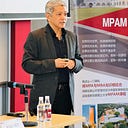Keeping people from dying is good for business
Or, the Prevention Paradox in Public Health is an instance of Externalities in Economics (or more generally of Emergence in Complexity Analysis).
by
Danny Quah
May 2020
Historical evidence on the 1918 Flu, analysed by Correia et al, shows those US cities that afterwards experienced sustained higher manufacturing employment growth had also (1) seen lower mortality from the epidemic; and (2) put in place stronger public health intervention in the form of social distancing, quarantine, and lockdown.
In the 1918 Flu the cure wasn’t worse than the disease; the cure, sensibly enough, was what kept the disease in check. And the local economy thrived afterwards, when both public health intervention strengthened and fewer people died.
Why this systematic variation? If individuals and businesses rationally come to an assessment of the risks and hazards they face, shouldn’t employment growth after the pandemic be simply residual uncorrelated randomness? The reason is, in an epidemic, we cannot rely on individually-rational judgment leading to the right decision.
Non-pharmaceutical intervention such as social distancing, quarantine, and lockdown resolve a coordination problem when people don’t take into account how their individual actions spill over into community well-being. Left to their own devices, people might be pretty good at assessing risk to themselves. However, they also systematically over-discount the resulting risk to those around them and to society more generally. Inadvertently spreading flu will result in excessively-reduced consumption and overly-lowered labour supply (i.e., negatively affecting both demand and supply) in an externality-driven way, i.e., in aggregate more than an individual assesses probabilities for themselves.
What economists call externalities turns out to be what public health specialists call the Prevention Paradox: “a preventative measure has a high health benefit for the overall population but is seen to be doing little good for the individual”. Hence, individuals rebel — quietly or in some cases not so quietly — against public health measures that are, paradoxically, in their self-interest to accept.
In Correia et al’s analysis, the key East-West variation that drove policy responses across US cities during the 1918 Flu is that America’s Western cities learned from the experiences of Eastern ones: the East suffered the epidemic earlier. Then when it came their turn, Western cities took more effective policy measures.
Stepping outside the 1918 historical analysis, unfortunately, this timeseries variation seems to have been negated in the current COVID-19 pandemic. Policy-makers in many Western nations seem not to have taken seriously and quickly enough lessons learnt in the earlier-affected East about the effectiveness of contact-tracing, testing, and social distancing; about the possibility of multiple waves; and about the aggregate danger of pockets of social congestion — whether those be foreign workers in dormitories; fellow citizens packed together in favelas, slums, ghettos, congested public housing, prisons, or old-age retiree homes; or even rich people banded together in gated communities or high-rise luxury enclaves.
As more studies like Correia et al’s sharpen understanding on the parameter values regulating the efficient frontier of employment, mortality, and social distancing, so too will policy-makers be able better to work out the sequencing needed to recover from lockdown.
Graphic from Sergio Correia, Stephan Luck, and Emil Verner, “Fight the Pandemic, Save the Economy: Lessons from the 1918 Flu,” Federal Reserve Bank of New York Liberty Street Economics, March 27, 2020, https://libertystreeteconomics.newyorkfed.org/2020/03/fight-the-pandemic-save-the-economy-lessons-from-the-1918-flu.html.
